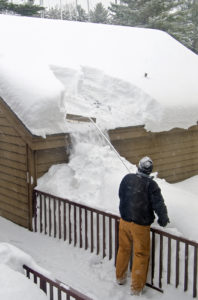How To Safely Remove Snow From Your Roof

Keeping the Weight Off
Beyond ice dams, accumulated snow and ice can also add weight to your roof, which can also cause other problems. One square foot of one-inch thick snow weighs about one pound. One big snowfall, or many small, accumulated snowfalls, can really add weight to what your roof.
Once the snow turns to ice, it becomes an even bigger problem, as one cubic foot of ice weighs approximately 57 pounds. That’s asking a lot of a structure that is already being assaulted by cold weather and wind.
One of the more popular strategies for attempting to keep ice dams at bay that you may have seen in hardware stores is heat cables.
They attach to your roof around the edges and use electricity to heat up and melt any ice that may be forming near the edges.
However, they introduce their own problems. Running on what is called a “dead short circuit,” meaning the positive and negative wires are touching each other to produce the heat, these cables use a lot of electricity, and can frequently fail.
Dealing with Roof Ice and Snow
So what is the most effective way to keep your roof safe from ice and snow damage? There are many products on the market, but shoveling or raking is typically the most effective.
Of course, getting up on the roof is not advisable when it is snow and ice-covered, so a long-handled tool is the best so you can work from the ground. It’s also important to use the right tool. Tools with sharp points can damage your roof’s protective membrane, increasing the problem.
When in doubt, it’s always a good idea to contact a roofing professional. A professional roofing contractor has the experience (and the tools) to make roof snow and ice removal safe and effective.
If you live in a one-story home, snow removal may not be as much of a challenge. However, for those that live in multi-level residences, it can be a different story.
Don’t Be Afraid to Call a Roofing Professional
When roof-raking isn’t enough, you may need to employ a shovel. Wet snow, ice or intricately angled roofs can cause problems for raking.
Shoveling is necessary after a huge snow, or if the job requires heavy lifting. A good rule of thumb is to remove ice and snow as soon as it reaches six inches of depth. That’s when the weight starts becoming too much stress, and also when ice dams are most likely to form.
Even if you are proactive about keeping ice and snow off your roof, you can still end up with roof damage. For repairs that keep your home safe and dry, call All-Nu Construction for all your roof repair needs. We’re the roofing contractors in Toledo that you can count on.

